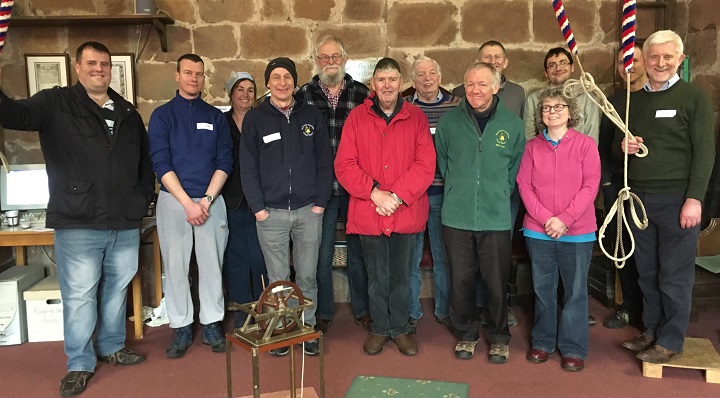M1: 10 Feb 2018 - Eccleshall
On Saturday 10th February twelve North Staffs ringers met at Eccleshall for a 'Module 1 - Teaching Bell Handling' Day course led by Paul Lewis. We discussed recruiting and retaining new ringers and how to encourage them through the (sometimes lengthy) process of learning to handle a bell. We all agreed that the initial bell handling lessons should be frequent and intensive, rather than a few minutes on a practice night. We discussed the 'Whole-Part-Whole' approach which recommends learning and practising individual handling movements intensively and accurately, combining them to ring both strokes together, and then returning to practise handstrokes and backstrokes separately to refine any inaccurate movements. It is very important that new ringers do not repeat inaccurate handling over and over again, because the body remembers these movements and they will be very hard to unlearn. We looked at different learning styles, and the Learning the Ropes materials available for new ringers and teachers through ART. Up in the tower we shared and demonstrated our individual methods of teaching bell handling: the ways we taught backstrokes and handstrokes separately, and how we addressed the trickiest part – putting them together. It was very apparent that we had different ways of teaching, but we all gained some interesting tips and ideas from each other. We discussed teaching left-handed ringers and tall ringers who might need the rope taking up on the wheel, the pros and cons of using a dummy tail end and how to teach in a way that maintained the tension on the rope for the learner, so that they could feel the effect on the bell from their pulls.
In the afternoon we moved on to teaching a learner to ring a bell up and down and making coils in the rope. There was a lot of “how do I actually lose the last coil when I’m ringing up?” and we noticed quite a lot of variation between us when we analysed the movement.
The last session of the day covered common handling faults and how to spot and rectify them. Paul made us ring rounds as if we were left-handed ringers, or right-handed if we were one of those much-mocked left-handed ringers anyway. Suddenly everyone’s ringing looked a lot more precarious, and it raised a good laugh, but it was a very good reminder of how unnatural and difficult the bell handling process must feel for learners when they first start ringing.
Overall it was a very interesting day. Very often we teach handling one-to-one without another teacher present, so sharing our experience was very useful. We all need to be the best teachers we possibly can; with the current shortage of ringers, every new ringer needs to develop a good handling style, so that they can progress in their ringing as far as possible. Not every new ringer will enjoy ringing enough to carry on with it, but we don’t want to lose enthusiastic ringers because they’ve been trying to Plain Hunt the treble for a year and poor bell handling is preventing them being able to do it.
Lorna E Champney

Course Tutor: Paul Lewis
Teaching Bell Handling
Practical advice for teachers, right from the first lesson.